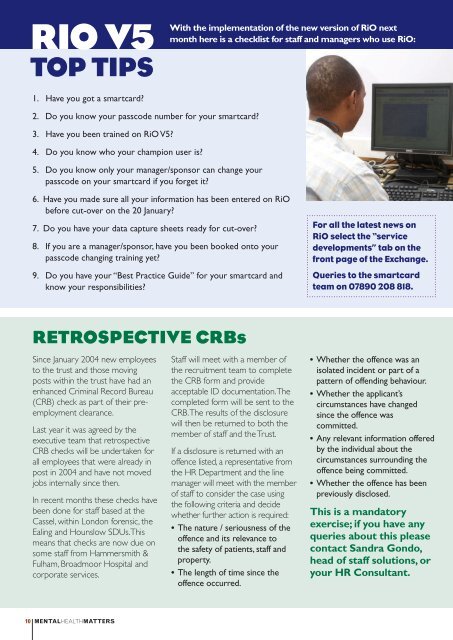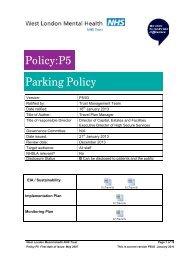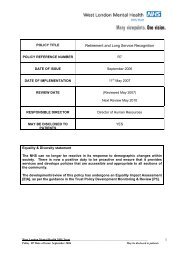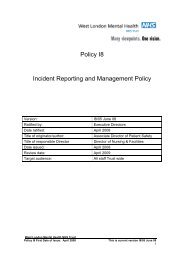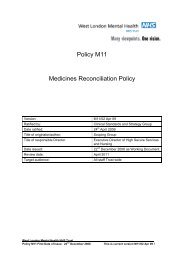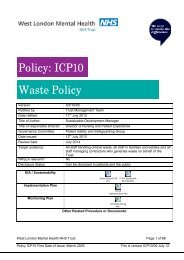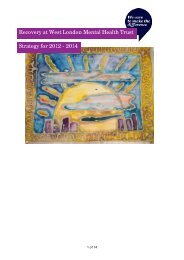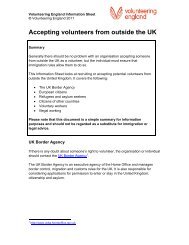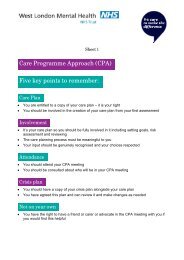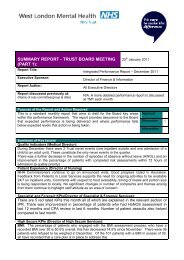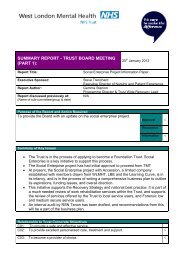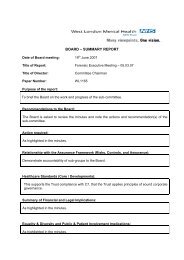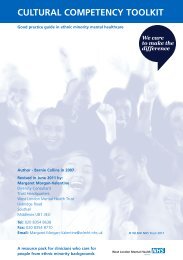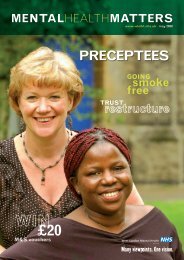children - West London Mental Health NHS Trust
children - West London Mental Health NHS Trust
children - West London Mental Health NHS Trust
Create successful ePaper yourself
Turn your PDF publications into a flip-book with our unique Google optimized e-Paper software.
RIO V5<br />
top tips<br />
With the implementation of the new version of RiO next<br />
month here is a checklist for staff and managers who use RiO:<br />
<strong>Trust</strong> restructure<br />
A personal perspective by Kelvin Cheatle,<br />
executive director for workforce and environment.<br />
1. Have you got a smartcard?<br />
2. Do you know your passcode number for your smartcard?<br />
3. Have you been trained on RiO V5?<br />
4. Do you know who your champion user is?<br />
5. Do you know only your manager/sponsor can change your<br />
passcode on your smartcard if you forget it?<br />
6. Have you made sure all your information has been entered on RiO<br />
before cut-over on the 20 January?<br />
7. Do you have your data capture sheets ready for cut-over?<br />
8. If you are a manager/sponsor, have you been booked onto your<br />
passcode changing training yet?<br />
9. Do you have your “Best Practice Guide” for your smartcard and<br />
know your responsibilities?<br />
Retrospective CRBs<br />
Since January 2004 new employees<br />
to the trust and those moving<br />
posts within the trust have had an<br />
enhanced Criminal Record Bureau<br />
(CRB) check as part of their preemployment<br />
clearance.<br />
Last year it was agreed by the<br />
executive team that retrospective<br />
CRB checks will be undertaken for<br />
all employees that were already in<br />
post in 2004 and have not moved<br />
jobs internally since then.<br />
In recent months these checks have<br />
been done for staff based at the<br />
Cassel, within <strong>London</strong> forensic, the<br />
Ealing and Hounslow SDUs. This<br />
means that checks are now due on<br />
some staff from Hammersmith &<br />
Fulham, Broadmoor Hospital and<br />
corporate services.<br />
Staff will meet with a member of<br />
the recruitment team to complete<br />
the CRB form and provide<br />
acceptable ID documentation. The<br />
completed form will be sent to the<br />
CRB. The results of the disclosure<br />
will then be returned to both the<br />
member of staff and the <strong>Trust</strong>.<br />
If a disclosure is returned with an<br />
offence listed, a representative from<br />
the HR Department and the line<br />
manager will meet with the member<br />
of staff to consider the case using<br />
the following criteria and decide<br />
whether further action is required:<br />
• The nature / seriousness of the<br />
offence and its relevance to<br />
the safety of patients, staff and<br />
property.<br />
• The length of time since the<br />
offence occurred.<br />
For all the latest news on<br />
RiO select the “service<br />
developments” tab on the<br />
front page of the Exchange.<br />
Queries to the smartcard<br />
team on 07890 208 818.<br />
• Whether the offence was an<br />
isolated incident or part of a<br />
pattern of offending behaviour.<br />
• Whether the applicant’s<br />
circumstances have changed<br />
since the offence was<br />
committed.<br />
• Any relevant information offered<br />
by the individual about the<br />
circumstances surrounding the<br />
offence being committed.<br />
• Whether the offence has been<br />
previously disclosed.<br />
This is a mandatory<br />
exercise; if you have any<br />
queries about this please<br />
contact Sandra Gondo,<br />
head of staff solutions, or<br />
your HR Consultant.<br />
Back in the 1980s, when I was<br />
studying for a career in HR (it was so<br />
long ago it was then called personnel<br />
and training!) the management guru<br />
of the day was Charles Handy. He<br />
wrote books such as “Understanding<br />
Organisations” and the “Empty<br />
Raincoat” in which he talked about<br />
the need for organisations to adopt<br />
structures that suited their business<br />
needs and adapt them as they went<br />
along. He was very critical of structural<br />
change for the sake of it and saw it<br />
as a sign of organisational weakness<br />
as it usually created instability and<br />
confusion.<br />
Change has become a way of life for<br />
those of us who work in the <strong>NHS</strong><br />
and the <strong>NHS</strong> itself has been through<br />
more reorganisations than England<br />
has football managers. Although there<br />
are changes all around us the trust<br />
itself has actually had a remarkably<br />
stable configuration by modern<br />
standards for an extended period.<br />
In 2000, when the merger between<br />
Broadmoor Hospital Authority and<br />
Ealing Hammersmith and Fulham <strong>Trust</strong><br />
was being put together, the forensic<br />
and local services divisional structure<br />
was designed and implemented when<br />
the <strong>West</strong> <strong>London</strong> <strong>Mental</strong> <strong>Health</strong><br />
<strong>Trust</strong> was created in April 2001. That<br />
structure lasted until 1 October 2008<br />
when the new five service delivery<br />
units were created; seven years of<br />
organisational stability by modern<br />
standards is quite a long time and<br />
indeed, the trust’s current portfolio<br />
of services, has remained largely<br />
unchanged since the Hounslow Adult<br />
<strong>Mental</strong> <strong>Health</strong> Services became part<br />
of the organisation in April 2002.<br />
So whilst we can all be forgiven for<br />
thinking that structure is changing<br />
every year, we have had a remarkably<br />
stable period.<br />
However, the creation of the five<br />
service delivery units is a significant<br />
shift in the way the organisation<br />
runs. So, have we been guilty of what<br />
Charles Handy called reshuffling of<br />
the deck chairs, or have we sensibly<br />
adapted the trust structure to reflect<br />
the world we are now living in? Well<br />
I like to think that we have taken<br />
Charles Handy’s advice and sensibly<br />
adapted the structure. There are<br />
a number of compelling reasons<br />
to do away with the old local and<br />
forensic divisions. Firstly, they no<br />
longer reflect the way money flows<br />
into the organisation or the clinical<br />
pathways through which our patients<br />
proceed. It makes much more sense<br />
to organise our services around the<br />
way they are commissioned by PCTs<br />
and other commissioning groups (as<br />
in the case for the <strong>London</strong> forensic<br />
and Broadmoor services) and the<br />
geography or patch which our<br />
services are serving (which of course<br />
has always been the model for Ealing,<br />
Hounslow and Hammersmith and<br />
Fulham). The new arrangements not<br />
only support the way the money<br />
and the patients services flow, but<br />
also our relationships with PCTs, local<br />
authorities and other partners, around<br />
those localities.<br />
...............................................<br />
the creation of the five<br />
service delivery units is a<br />
significant shift in the way<br />
the organisation runs<br />
...............................................<br />
No change is without pain of course<br />
and creating a universal model, where<br />
older people services, CAMHS and<br />
adults services sit side-by-side, in the<br />
three <strong>London</strong> boroughs, has created<br />
concerns for staff that their services<br />
will lose their identity and focus in the<br />
new SDU world.<br />
To deal with those of course<br />
necessarily means we have to become<br />
quite creative in the structures that<br />
exist below the SDU director level,<br />
to make sure those services have<br />
the right clinical representation and<br />
management arrangements, to<br />
ensure that they not only survive but<br />
thrive in the new regime. It is equally<br />
important that services like the Cassel<br />
Hospital and the gender identity<br />
services in Hammersmith also obtain<br />
a high profile, as they are national<br />
services, highly valued and respected<br />
way beyond the boundaries of <strong>West</strong><br />
<strong>London</strong> <strong>Mental</strong> <strong>Health</strong> <strong>Trust</strong>.<br />
The concept around the creation of<br />
<strong>West</strong> <strong>London</strong> <strong>Mental</strong> <strong>Health</strong> <strong>Trust</strong><br />
in 2000 was that it became a large<br />
speciality mental health trust that<br />
provided the whole spectrum of<br />
mental health services, across a broad<br />
catchment area and a personal view<br />
is that the creation of the five SDUs<br />
is a better way of both protecting<br />
the identities of all those services, but<br />
making sure that they can navigate the<br />
complex world around us successfully<br />
in the years to come.<br />
The board will be undertaking a full<br />
evaluation of the structural changes<br />
later this year to ensure that the<br />
desired outcomes have been achieved.<br />
10 MENTALHEALTHMATTERS MENTALHEALTHMATTERS 11


